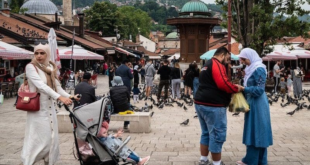 Relatives of those massacred in 1995 are dismayed by reports that their loved ones’ exhumed possessions may since have been destroyed without their permission.
Relatives of those massacred in 1995 are dismayed by reports that their loved ones’ exhumed possessions may since have been destroyed without their permission.
Families of the men and boys killed in Srebrenica are in uproar over claims that personal things taken by ICTY investigators from mass graves located in 1996 and 1997 were later destroyed.
Available data suggest the items might have been destroyed after having been stored in a container on the grounds that they had started decomposing.
The Hague Prosecution has not denied or confirmed allegations concerning the destruction of the material found during the course of investigations. However, members of victims groups who met with the Chief Prosecutor in Sarajevo last week insisted he told them some material was destroyed.
Bosnian Presidency member Haris Silajdzic condemned reports of the destruction of this items, saying that he would call on the Chief Prosecutor to open an investigation.
“Allegations suggesting that the destroyed material included a large number of personal identification cards found with the Srebrenica victims’ bodies is particularly shocking”, he said, as was the claim that “ID cards were burnt in an industrial garbage depot at the Hague”.
BIRN began to investigate the story after journalist Michael Montgomery wrote about the case on his Blog, alleging that the destroyed material included a certain number of identification cards found in mass graves in which the killed Srebrenica residents were buried.
Similar case is about the destruction of some documents at the Hague, pertaining to possible crimes committed in Kosovo in the course of 1999. It is alleged that physical evidence, suggesting certain body parts were traded, were destroyed at the Hague. See: Investigation: KLA Ran Torture Camps
The materials were found during the course of an investigation, conducted in Albania, on allegations that some civilians, who were captured by the Kosovo Liberation Army, were taken away and killed, so that their body parts could be sold later on. Read the Interview with Michael Montgomery.
Destroyed for hygienic reasons?
The massacre of thousands of Bosniak men and boys in Srebrenica by the Republika Srpska army under General Ratko Mladic occurred in July 1995.
After the Bosnian Serbs entered the town in eastern Bosnia on July 11, more than 8,000 civilians were butchered. Till now, the remains of more than 3,000 have been found in mass graves. The others have still not been found.
The first mass graves were discovered as early as in 1996 in the villages of Pilice, Cerska and Kozluci. Amor Masovic, then Head of the Federal Commission for Missing Persons, who attended the exhumation of most mass graves later on, says neither he nor the local authorities had access to those locations in that year.
“The ICTY investigators came [and] I know that they found some things on the surface. I know that there were family albums, photos, personal documents,” he told Justice Report.
“Bosnian people were used as physical labour for digging the graves at the time. They [ICTY] took the things with them. I suppose they needed them as help in identifying the victims, because there were no DNA laboratories in Bosnia at the time. I do not know what happened to those materials,” Masovic added.
Families of the Srebrenica victims were in a state of disbelief when they heard that some of their loved ones’ personal things might have been destroyed.
“I have never heard of such a thing. It is hard to believe,” Hajra Catic, who left Potocari after joining a convoy of other women in July 1995, told Justice Report.
Catic says that most Srebrenica residents did not carry their personal documents on them when they were leaving the town.
“We simply didn’t think about that, considering all other things that were happening at the time,” Catic recalled.
Catic made this statement one day before the meeting between Brammertz and representatives of the associations of victims in Sarajevo.
Following the meeting, the Prosecutor did not address the media, but the victims’ families did. Catic was shocked by reports that said Brammertz had confirmed that some materials had been destroyed.
The Hague Prosecution has not denied or confirmed allegations concerning the destruction of the material found during the course of investigations.
“I can neither confirm nor deny that the material was destroyed,” spokesperson Olga Kavran said a few days after the Chief Prosecutor returned to the Hague from a visit to Sarajevo.
Associations of victims, whose members met with the Serge Brammertz, Chief Prosecutor of the International Criminal Tribunal for former Yugoslavia, ICTY, at a closed meeting, say he told them that some material was destroyed “as per the existing procedures”.
However, the Prosecution denies this, insisting Brammertz’s words have not been correctly reported.
Munira Subasic, the Association President, who attended the meeting, said she asked Brammertz to explain why the evidence had been destroyed.
“He said they did it for hygienic reasons because the material had started decomposing,” she said. “He said that this had not been done during the course of his mandate, adding that this was in line with regular procedures.”
Subasic added that the Prosecutor had said data about the material were included in the Prosecution’s database. Nevertheless, Subasic said they had expressed their dissatisfaction about this, and would do so again when she visited The Hague next month.
“We knew that ICTY investigators attended the exhumations and took away some things found there,” she said. “If an exhumation is carried out by local people, they call members of families and they ask what they want to be done with the things they find,” Subasic added.
Murat Tahirovic, President of the Association of Detainees of Bosnia and Herzegovina, who attended the same meeting, echoed her words.
“We heard that some material had been destroyed earlier, but we did not have any confirmation and we did not know what material was in question,” she said.
“We understand that they were some photos or something like that. During our conversation with the Prosecutor, he explained what this was all about, telling us that the material was starting to decompose and they were forced to destroy it. He claimed it was the property of the Tribunal,” Tahirovic added.
The Hague Prosecution disputes this. “What the Prosecutor said in Sarajevo was: ‘In line with the procedures, similar to the ones applied by national judicial institutions, the gathered material that is not needed for court proceedings can be destroyed if, for example, it represents a threat to people’s health,’” spokesperson Olga Kavran said.
‘In such situations, detailed data on the material as well as the photographs of the material would be kept on file,’” Kavran added.
Asked to clarify the procedures she mentioned, Kavran said that she could not provide “any additional explanations, because this pertains to internal Prosecution procedures”.
Tahirovic says that not only were they told that material had been destroyed, but that the items were photographed prior to destruction and the photographs were allegedly archived.
“We are determined to take some action, though honestly I do not know what is the best thing to do. To tell you openly, I am not sure if we have got a solution to the current problem,” Tahirovic said.
An irreplaceable loss:
Amor Masovic says that local personnel, involved in finding and exhuming mass graves, take good care of the personal things they find.
“We hand them over to police, who then give them to the families. The families then decide what they want to do with them,” he said.
“We used to find various types of things, like razors, photographs, jewelry, watches… In most cases families decide to keep them as they are of great emotional value to them,” Masovic added.
Munira Subasic, who lost her husband and son in Srebrenica, is familiar with this procedure. Nearly 15 years after his death, a cigarette box was found alongside the remains of her husband.
“I gave it to the Memorial Centre [in Potocari],” she said. “This is where it is kept now. Whoever comes by can see his name and something that belonged to him. This is all he left behind.”
“If it appears that primary sources were destroyed, this would be a large-scale scandal,” Sasa Madacki, of the International Association of Information Experts – librarians, archivists and curators, told BIRN – Justice Report.
“If it proves to be true, because I still cannot believe that it can be true,” he added. “Try to imagine someone destroying a part of artifacts kept in the Holocaust Museum or Yad Vashem or Auschwitz for hygienic reasons. This is nonsense and is extraordinary particularly today when we have various methods of disinfections, conservation and restoration.”
Madacki added that he could not see how the Tribunal, as a court institution, lacked the adequate technology to preserve items.
“Failure to offer the collected material to the families or to Memorial Centre in Potocari is something I cannot understand,” he continued.
The Yad Vashem museum in Jerusalem was formed, among other things, by collecting the personal things that had belonged to victims. At present, the museum stores about 1,200 artifacts, in addition to documents, photographs and movie clips.
Among these things are a doll found in a detention camp, a postcard sent from Auschwitz, personal letters and family photos. Besides, the museum keeps personal stories told by the families to which the things belonged.
Photographs and personal things also comprise part of the collection of the Auschwitz Museum in Poland. They hold 135 photographs, some taken by the Nazis in the detention camp.
Personal things that belonged to victims can also be found in the Holocaust Museum in Washington, where one can see shoes, clothes, bags, glasses and other similar items.
For the time being, the Memorial Centre in Potocari has only a small number of lighters, tobacco boxes, keys and photo albums but it plans to collect as many as possible.
“These small objects help us tell personal stories about the men and boys who were killed under the horrible circumstances,” says a note kept in the Memorial Room.
Tilman Zulch, President of the The Endangered Peoples Society, based in Germany, said the destruction of personal objects found in mass graves was always a scandal.
“Destroying personal identity cards, photographs, watches and clothes that belonged to killed Srebrenica residents means inflicting injustice and pain for the second time on mothers, sisters, daughters and relatives who have been waiting to find out what had happened to them for years,” Zulch said.
“On behalf of the surviving women and children of Srebrenica, we would like to call for a storm of protests,” Zulch added.
Fadila Memisevic, president of the Bosnian branch of the Endangered Peoples Society, said a new section of the museum would be opened in the halls of the former Battery Factory in Potocari, which now belong to the Memorial Centre complex, and in which the Dutch Battalion was based until July 1995.
“Once opened, all the gathered documents and objects that belonged to killed Srebrenica residents will be kept in the museum,” she said.
“Unfortunately, the families of victims whose belongings were destroyed at the Hague will not have an opportunity to exhibit them at this museum,” Memisevic added.
“This material was of enormous historical value to our country. Those objects could have been kept in a future genocide museum, which would be opened at some stage. If we are really talking about 1,000 objects, and some people say that there were as many as 3,000, this is an enormous loss,” she continued.
“The fact that all this was done without informing our authorities is shocking. Had they been offered to Bosnia and Herzegovina, I am sure that they would have accepted and kept those and all other objects.” said Amor Masovic.
 Eurasia Press & News
Eurasia Press & News



